 klaus-michael schneider
klaus-michael schneider
Keywords: education |
Links: FOTW homepage | search | disclaimer and copyright | write us | mirrors

Last modified: 2021-02-05 by  klaus-michael schneider
klaus-michael schneider
Keywords: education |
Links: FOTW homepage |
search |
disclaimer and copyright |
write us |
mirrors
![[Flag of Colombia]](../images/c/co.gif) (2:3)
(2:3)  image by Željko Heimer, 20 May 2001
image by Željko Heimer, 20 May 2001
See also:
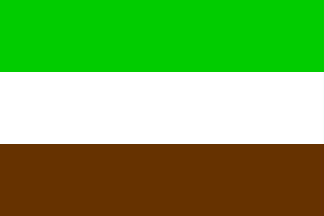 image by Ivan Sache, 28 March 2009
image by Ivan Sache, 28 March 2009
"Escuela Normal Superior 'Sor Josefa Del Castillo y
Guevara' " was founded in the 1950s at Chiquinquirá,
Department of Boyacá. The institute is named after Venerable
Mother Josefa Del Castillo y Guevara (1671-1742), called
"St. Teresa of America"; her works, eventually
published in 1968, include her autobiography ("Mi
vida" / "My Life") and a mystic treatise
("Afectos espirituales" / "Spiritual
Affections").
The flag of the institute, as shown graphically and described on
the institute's
website, is horizontally divided green-
white-"carmelite" ("carmelito").
"Carmelite" must be here the brown colour of the
Carmelite mantle.
Green represents hope.
White represents purity.
"Carmelite" represents the union of souls with duty,
the commitment of the life to the service of mankind in its most
noble way, education.
Ivan Sache, 28 March 2009
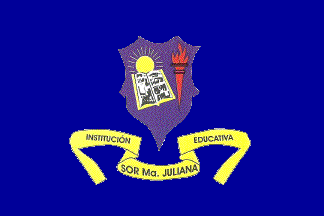 image by Ivan Sache, 06 September 2014
image by Ivan Sache, 06 September 2014
Institución Educativa Sor María Juliana was established in Cartago (Valle
Department) on 25 February 1927 by the noted pedagogue Albertina Hoyos. Aimed
at educating the future mothers of the town, the institute was subsequently
renamed Escuela Complementaria, directed by the teacher Pastora Murillo, who
ended her life as a Franciscan nun. The alumni of the institute were famous for
their calligraphic writing and perfect orthography, as well as for all kinds of
household skills. The institute was renamed in 1958 Liceo Femenino de Comercio
and, in 1965, Instituto Sor María Juliana. The institute was renamed for a
teacher of Colegio María Auxiliadora highly estimated by Ruby Gonzáles, the
director of the institute. The lawyer Leonor García Ramírez, director of the
institute from 1977 to 1997, obtained in 1983 yet another name change, for
Instituto de Bachillerato Técnico Comercial Sor María Juliana. Institución
Educativa Sor María Juliana was eventually established by Law No. 1,667 of 3
September 2002.
The flag of the institute is blue with the institute's emblem in the middle.
Blue, the colour of the immense sky, is a symbol of progress, highest
aspirations, and willingness to learn and to experiment.
Source:
http://iesormariajuliana.edu.co/?page_id=407 - Institute's website
The emblem of the institute, designed by Luis María Franco, is blue, with the
same symbolism as the flag, featuring:
- a sun, meaning the light of truth, science and knowledge:
- an open book, meaning willingness and empowerment for a better future;
- a torch, whose flame means compromise and integrity.
Source:
http://iesormariajuliana.edu.co/?page_id=404 - Institute's website
Ivan Sache, 06 September 2014
 image by Ivan Sache, 16 December 2008
image by Ivan Sache, 16 December 2008
"Colegio Stella Matutina" (in Latin, "Morning
Star", a personification of the Blessed Virgin invoked in
the "Litany of the Blessed Virgin Mary" /
"Litaniae lauretanae") was inaugurated in 1962 by the
Congregation of the Sisters of Bethany ("Congregación
Hermanas de Bethania"). Founded by two nuns, Dolores de
María Zea and María de la Cruz Pinto, born in Guatemala and
Salvador, respectively, the congregation was canonically approved
on 20 January 1928 by His Grace José Alfonso Belloso y Sánchez,
Bishop of San Salvador, on behalf of Pope Pius XI.
The flag of the institute is horizontally divided blue-green,
meaning "from the Earth to Heavens" and symbolizing the
hope in heavens. The flag is hoisted, together with the national
flag of Colombia, in front of the institute.
Source: <www.stellamatutina.edu.co>.
Ivan Sache, 16 December 2008
![[Colegio de Sugamuxi current]](../images/c/co_csugam.gif) image by Ivan Sache, 17 July 2014 |
![[Colegio de Sugamuxi former]](../images/c/co_csugam1.gif) image by Ivan Sache, 28 March 2009 |
"Colegio de Sugamuxi" (COLSUGA) was founded on 12
October 1905 by Dr. Joselyn Parada Leal at sogamoso, the capital
of the Province of Sugamuxi, Department of Boyacá. By Decree No.
17 of the Departmental Assembly, the institute became in 1937 a
Departmental School, whose named was changed in 1939 to
"Academia Militar del Sugamuxi" or "Colegio del
Sugamuxi, Academia Militar". Renamed in 1975 "Colegio
Nacional de Sugamuxi", the institute has always been known
under its historical name, "Colegio de Sugamuxi", even
if its current legal name is "Institución Educativa
Sugamuxi".
The flag of COLSUGA, as described on the institute's
website, is horizontally divided olive greenish
("aceitunado")-white with a yellow-orange
("amarillo-naranja") triangle placed along the hoist.
The triangle was added in 1985 to the former flag, horizontally
divided olive greenish-white, whose adoption date is unknown, to
distinguish the flag of the institute from the flag of other
public and private bodies. Exact proportions and shades not
known.
Ivan Sache, 28 March 2009
The flag in use is charged with the institute's emblem.
http://colegio-sugamuxi.blogspot.fr/2009/11/bandera.html - Photo
The
emblem was adopted in 1953.
http://colegio-sugamuxi.blogspot.fr/2009/11/escudos.html - Institute's
website
Ivan Sache, 17 July 2014
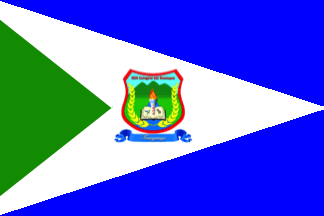 image by Ivan Sache, 12 December 2020
image by Ivan Sache, 12 December 2020
The flag of Institución Educativa Municipal Integral del Sumapaz, a school
located in Fusagasugá (Cundinamarca), is blue with a white triangle spreading
from the hoist to the mid-fly, itself charged with a green triangle placed along
the hoist and with the school's coat of arms.
Blue represents water,
white represents peace, and green represents the natural environment.
The
coat of arms has a green field and mountains, representing the Sumapaz region.
The blue sector represents water flowing down from the mountains.
The golden
yellow spikes represent the region's main source of income.
The open book
represents opening to knowledge.
The gear represents technological knowledge.
The colibri, as a bird representative of the region, represents knowledge and
protection of the natural environment.
The celestial blue sky represents
values as source of transparency.
The flaming torch represents passion and
love.
https://www.insu.edu.co/sitio/index.php/nuestra-institucion/simbolos
INSU website
Ivan Sache, 12 December 2020
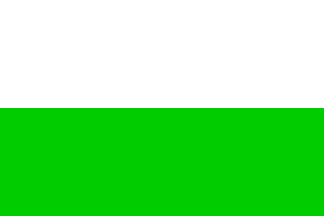 image by Ivan Sache, 12 August 2014
image by Ivan Sache, 12 August 2014
Institución Educativa Supía is established in the municipality of Supía
(Caldas Department).
The flag of the institute is horizontally divided white-green. White is a symbol
of beauty, transparency, responsibility, clarity, and light. Green is a symbol
of vegetation and natural resources.
Source:
http://karenliced5.wix.com/institucion-educativa-supia#!bandera -
Institute's unofficial blog
Ivan Sache, 12 August 2014
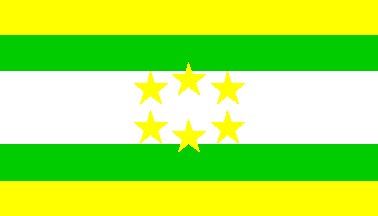 image by Ivan Sache, 29 January 2009
image by Ivan Sache, 29 January 2009
"Institución Educativa Rural del Sur" (of the
South) was founded in the Municipality of Tunja, Department of
Boyacá, on 20 September 2002 (Decree No. 02424).
The flag of the institute, as shown graphically and described on
the
website of the institute, is horizontally divided
yellow-green-white- green-yellow (1:1:2:1:1) with six yellow
stars in the middle. Yellow represents wisdom, maturity, wealth
and generosity, and, on the flag, an allegory of the rural
resources in the municipal context and of the common interests
shared by the whole community. Green represents the agricultural
productivity but also aspirations to a better future supported by
science, technology and technique, expected to provide a better
standard of life to the inhabitants. White represents peace,
balance and sustainable development. The stars are symbols of
light, strength, knowledge and victory, each representing a seat
of the institute and their institutional interactions.
On the emblem of the institute, designed by Dr. Carlos Cuervo
Escobar, the second quarter is yellow with the flag of Tunja
(horizontally divided green-white-green, probably a source for
the flag of the institute) and the flag of the institute crossed
per saltire.
Ivan Sache, 29 January 2009
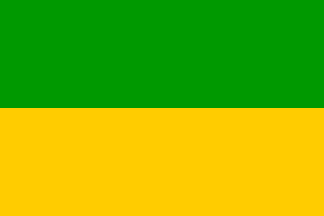 image by Ivan Sache, 21 November 2014
image by Ivan Sache, 21 November 2014
Institución Educativa Susana Guillemin was established in Bélen (Boyacá
Department) on 20 February 1965 by a group of ladies of the town and Daughters
of Charity (Vicentians). The institute was named for the Superior of the
community, while Sister Margarita Martínez was appointed its first director. The
institute was placed under departmental management by Decree No. 171 of 7 March
1968.
The flag of the institute is horizontally divided green-golden yellow. Green is
a symbol of hope, good and strength. Golden yellow is a symbol of progress,
justice and union.
Source:
http://investigacionietsusanaguillemin.blogspot.fr/p/nuestra-institucion.html
Ivan Sache, 21 November 2014